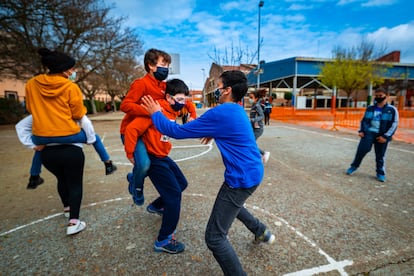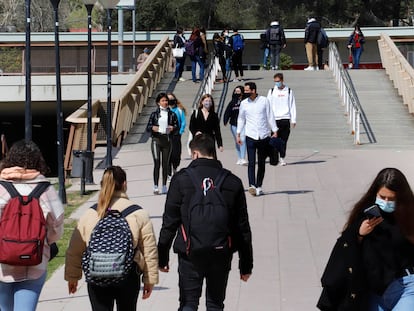Spain wants to keep face masks and distancing at schools during next academic year
Central government is seeking to convince regional authorities to maintain coronavirus measures in place despite an improving situation aided by the vaccination campaign

Spain’s central government is proposing that coronavirus prevention measures be maintained at schools during the next academic year, according to a document sent Thursday to regional authorities and to which EL PAÍS has had access.
The document, drawn up jointly by the Education and Health ministries, suggests keeping face masks mandatory for students who are aged and over when they return to school in September after the summer vacation. It also supports maintaining so-called bubbles – stable groups of students – or, failing that, keeping a safe distance between pupils.
But there is a relevant change regarding the distance between desks inside the classroom: it may be reduced to 1.2 meters, down from the current 1.5 meters. The goal is to make space for more students in each classroom, thereby guaranteeing in-person learning for students at all stages of the Spanish education system, including secondary school, Bachillerato (post-16 education comparable to British A-levels or the International Baccalaureate), vocational training and specialized arts and sports degrees.
In their proposal, the Health and Education ministries admit that the mixed system of learning used in secondary schools during the pandemic, featuring in-person classes only part of the week, has had a negative impact on many students.
The global dimension of the pandemic makes it necessary to maintain a scenario of prudenceDocument by the Health and Education ministries
If transmission were to rise, there would be a return to the mixed model. This would happen when parameters such as the cumulative incidence rate and intensive care unit (ICU) occupation reach the alert levels 3 and 4 on the Health Ministry’s coronavirus risk chart. “The teenage population’s ability to pass on the infection to others is similar to that of adults, and registered outbreaks have been more frequent in secondary education and Bachillerato,” reads the text.
If, on the contrary, the epidemiological situation were to improve to the extent that the government has defined as “the new normality” – involving a 14-day incidence of 25 cases per 100,000, a rate 4% or less of diagnostic tests coming back positive, and ICU occupation by Covid patients of up to 5% – then students from the same grade but different groups would be allowed to mix at recess, for group projects and during sports activities.
The government document asserts that the measures adopted this academic year “have worked” and that Spain has become “an international role model due to its ability to keep schools open” during the various waves of the pandemic.
In its proposal, the government – a leftist coalition of the Socialist Party (PSOE) and Unidas Podemos – also underscores the impact of the ongoing vaccination campaign, whose goal is to immunize 70% of adults by mid-August.
But it also warns that “the vaccination of children has yet to be defined,” and that the possibility of vaccinated people passing on the virus to others “cannot be ruled out.” There is also a mention of the various coronavirus strains currently in circulation and the fact that one or more could prove to be unresponsive to the vaccines.
“The global dimension of the pandemic makes it necessary to maintain a scenario of prudence,” reads the document, which is addressed to regional governments as the latter have devolved powers over education.
Permanent ventilation
As for the infrastructure itself, the government is recommending “permanent” ventilation whenever possible. Contact between groups should be kept to a minimum, and family-school interaction should continue to be conducted largely through telephone calls, emails and online tools.
It is the teachers who could be noticing the biggest differences come September. Most regional governments are planning to let go of the extra staff that was hired during the pandemic (around 35,000 teachers in total), despite calls by the education community to keep them on. In its proposal, the central executive is urging regional authorities to preserve these jobs, at least during the first few months of the 2021/22 academic year.
The proposal is open for amendments by the regions. There will be a meeting to assess technical aspects on Thursday, and another one to consider educational elements on Friday. On May 19, Education Minister Isabel Celaá and Health Minister Carolina Darias will meet with regional health and education officials to discuss the matter further.
English version by Susana Urra.
Tu suscripción se está usando en otro dispositivo
¿Quieres añadir otro usuario a tu suscripción?
Si continúas leyendo en este dispositivo, no se podrá leer en el otro.
FlechaTu suscripción se está usando en otro dispositivo y solo puedes acceder a EL PAÍS desde un dispositivo a la vez.
Si quieres compartir tu cuenta, cambia tu suscripción a la modalidad Premium, así podrás añadir otro usuario. Cada uno accederá con su propia cuenta de email, lo que os permitirá personalizar vuestra experiencia en EL PAÍS.
¿Tienes una suscripción de empresa? Accede aquí para contratar más cuentas.
En el caso de no saber quién está usando tu cuenta, te recomendamos cambiar tu contraseña aquí.
Si decides continuar compartiendo tu cuenta, este mensaje se mostrará en tu dispositivo y en el de la otra persona que está usando tu cuenta de forma indefinida, afectando a tu experiencia de lectura. Puedes consultar aquí los términos y condiciones de la suscripción digital.
More information
Últimas noticias
Most viewed
- Reinhard Genzel, Nobel laureate in physics: ‘One-minute videos will never give you the truth’
- Oona Chaplin: ‘I told James Cameron that I was living in a treehouse and starting a permaculture project with a friend’
- Pablo Escobar’s hippos: A serious environmental problem, 40 years on
- Charles Dubouloz, mountaineering star, retires at 36 with a farewell tour inspired by Walter Bonatti
- Why we lost the habit of sleeping in two segments and how that changed our sense of time











































